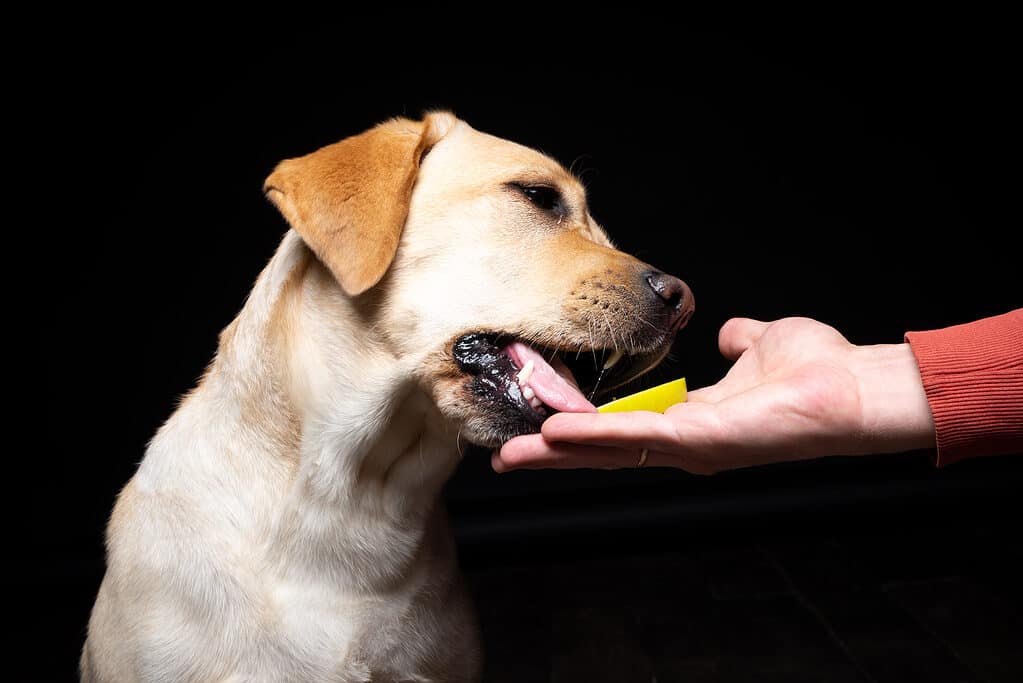Labradors are truly man’s best friend—these lively, loving pups make great dogs for active families because they always want to be in on the action!
As pets, they are friendly, cooperative, loyal, and active. They need a large, enclosed yard and plenty of daily exercise.
The Labrador retriever’s lifespan is similar to that of other large breeds at 10-12 years. Some Labradors live shorter lives than this, while plenty of well-cared-for dogs live a lot longer as well. The oldest Labrador lived to be 27 years old.
In this article, we’ll talk all about these beautiful pups, how long Labradors live, and the phases they go through from birth through to their senior years.
How Long do Labradors Live?

Labrador Retrievers are beautiful, gentle family dogs
.
©iStock.com/sanjagrujic
On average, Labrador Retrievers live 10-12 years. The oldest Labrador to ever exist was named Adjutant. He lived to be 27 years old and was far from the oldest dog in the world!
Lifespan can vary based on genetic health, care, and other factors. For instance, most labs will eat until they throw up if you let them—then go back for more!
Overweight dogs tend to live shorter lives, so it’s important to keep your Labrador on a balanced diet to prevent this.
If you purchase a Labrador from a breeder, always ask for veterinary records and ensure the dog was bred responsibly and ethically. Dogs who were poorly bred are also at risk for more health problems and a shortened life.
There are plenty of Labradors and lab mixes in shelters as well, awaiting adoption!
Labrador Development
Newborns

A newborn labrador retriever
©Avphoto.av/Shutterstock.com
Newborn puppies are born without the ability to see or hear. They depend on their mothers completely for warmth and sustenance.
At around two weeks, the puppies start to see, hear, and even stand on their own! They’ll begin interacting more with their environment, mother, and siblings.
When puppies turn four weeks old, the first key socialization period begins. They should get used to being handled by humans for short periods, while still spending the majority of their time with their mother and siblings.
Never adopt a Labrador puppy before eight weeks of age. Even once they are weaned, they still need this time to learn how to be a dog!
Their mother and siblings will teach them vital skills like bite inhibition, how to interact with other dogs, and more.
Puppyhood

A labrador retriever puppy
©Odua Images/Shutterstock.com
At 8-12 weeks, Labrador puppies typically go to their new homes. This is an exciting, but sometimes overwhelming, time in their lives!
Things should be taken at the puppy’s pace, with no crowding around them or rushing them into new situations before they’re ready.
Begin basic training at around three months old. Keep training sessions short and fun, using positive reinforcement methods only.
Discipline your dog when needed by redirecting bad behavior or calmly walking away and ignoring them for a few minutes at a time. This will teach them that they don’t get attention (negative or positive) for misbehavior.
Remember that puppyhood lasts until your dog is one to two years old—only then are they fully grown and mature.
Adulthood

Friendly, loving, and tolerant, the Labrador Retriever is a popular family dog.
©Grisha Bruev/Shutterstock.com
Labradors between one and two years old are considered adult dogs. They stop growing in height at one year old but may continue to fill out until their second birthday.
This is the prime time of your dog’s life. They need plenty of exercises to stay fit, including at least one daily walk, playtime, and space to run around outside.
Senior Years

A senior labrador retriever
©TM creations/Shutterstock.com
A Labrador is considered a senior dog at seven years old. They may be healthy and active for years to come, but they might also begin experiencing health problems such as trouble hearing, arthritis, or tumors.
Dogs over eight years old are at an 80% risk of having arthritis. They can still live full, happy lives, but may struggle with strenuous exercise such as running, jumping, or climbing stairs.
Labradors are also predisposed to developing lumps and bumps, which can range from harmless fatty tumors to life-threatening cancerous masses.
Bring your senior Labrador to the veterinarian for regular check-ups to keep them as healthy as possible.
What are the Most Common Causes of Labrador Death?
Tumors
Tumors are unfortunately common in Labradors. Female Labradors are most likely to develop tumors, with skin tumors on the chest and legs being the most common.
Tumors aren’t always cancerous or terminal. Your senior lab may develop a few lumps and bumps as they age, and your veterinarian can advise you on how to treat them. They may take a biopsy, opt for surgical removal, or suggest other options.
Arthritis
Labradors are prone to developing arthritis as they age. This in itself is not a death sentence for a dog, but it does impact their movement.
In the beginning stages, arthritis can be treated with supplements, pain pills, and other treatments as suggested by your veterinarian.
However, it may progress to the point where the dog has a very difficult time getting around, perhaps losing the function of their legs altogether.
It’s ultimately up to the owner and veterinarian to decide when the dog’s quality of life is impacted severely enough to consider euthanasia.
Heart Disease
Heart disease in Labradors stems from many factors which include diet, weight, and genetics. While keeping your dog on a healthy diet can decrease its risk, it won’t eliminate it.
If you notice symptoms of heart disease such as tiredness, coughing, or difficulty breathing, see your veterinarian right away.
Kidney Failure
Labradors can die of either acute or chronic kidney failure.
Acute kidney failure often happens when a dog eats something toxic and its kidneys shut down very quickly.
Chronic kidney failure, on the other hand, happens more slowly over time. It can have various causes, including poor dental hygiene.
Some ways to decrease your dog’s risk of kidney failure include regular teeth cleanings and dog-proofing your home so that your dog doesn’t have access to anything toxic.
How does the Labrador Lifespan Compare to Other Dogs?

Cute Labrador Retrievers, the most common dogs, lie on green grass in a summer park.
©New Africa/Shutterstock.com
In the animal kingdom, small animals such as guinea pigs live shorter lives, while larger animals such as whales live longer lives.
This is often inverted when you look at a specific animal, as is the case with dogs. Scientists don’t yet understand all of the reasoning behind this, although we’re beginning to get a clearer picture.
Large dogs grow more quickly than small dogs or even wolves. Breeding for large dogs may have caused the shortened lifespan.
Labradors do live shorter lives than smaller breeds, but they live just as long as other popular, large-breed dogs such as:
- Golden Retrievers – 10-12 years
- Siberian Huskies – 12-14 years
- American Bulldogs – 10-12 years
- Boxers – 10-12 years
Five Fun Facts About the Labrador Retriever

The Labrador Retriever is the national dog of Newfoundland and Canada’s official animal.
©EVGENII LEONTEV/Shutterstock.com
The Labrador Retriever is one of the most popular dog breeds in the world, and there are some interesting facts that you may not know about this lovable breed.
Here are five fun facts about the Labrador Retriever:
- The Labrador Retriever is the most popular dog breed in the United States.
- Labrador Retrievers were originally bred to help fishermen in Newfoundland, Canada.
- Labrador Retrievers are excellent swimmers and love to play in the water.
- Labs are known for their friendly, outgoing personalities and are great family dogs.
- Labs come in three colors: black, chocolate, and yellow.
The photo featured at the top of this post is © TM creations/Shutterstock.com
Ready to discover the top 10 cutest dog breeds in the entire world?
How about the fastest dogs, the largest dogs and those that are -- quite frankly -- just the kindest dogs on the planet? Each day, AZ Animals sends out lists just like this to our thousands of email subscribers. And the best part? It's FREE. Join today by entering your email below.
Thank you for reading! Have some feedback for us? Contact the AZ Animals editorial team.






